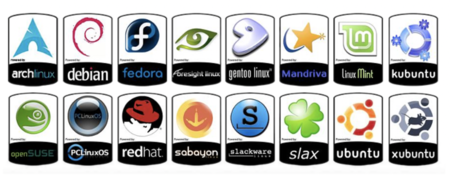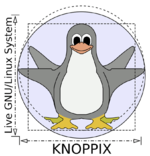Difference between revisions of "Tutorial7: Installing Linux / Live Linux / Virtualization"
(→Live Linux CD) |
(→Live Linux CD) |
||
| Line 104: | Line 104: | ||
The Knoppix Live CD id available to run on workstations at Seneca College or your home computer via '''AppsAnywhere'''. | The Knoppix Live CD id available to run on workstations at Seneca College or your home computer via '''AppsAnywhere'''. | ||
| − | ''Steps to Run Knoppix from AppsAnywhere:'' | + | :''Steps to Run Knoppix from AppsAnywhere:'' |
# | # | ||
Revision as of 07:40, 1 February 2020
Contents
INSTALLING LINUX / LIVE LINUX / VIRTUALIZATION
Main Objectives of this Practice Tutorial
- List and explain the common types of installing Linux
- Define and explain the purpose of using a Live Linux distribution
- Define and explain the purpose of Virtualization
- Compare running a Live Linux distribution from MyApps with booting a Live Linux CD
Tutorial Reference Material
| Course Notes |
Concepts |
YouTube Videos | ||
| Course Notes: | Installing Linux
|
Software
|
Instructional Videos:
| |
KEY CONCEPTS
Installing Linux
Having your own Linux system offers a great learning opportunity and gives you access to a large library of software.
Steps in the installation process:
- Select a Linux Distribution' and download'Bold text a Linux Distribution Install ISO File to your Computer
(Note: The OS requires compatible hardware) - Burn an Linux Distribution CD/DVD, or USB, or use downloaded file when creating a virtual machine
- Once booted, the installation process transfers the live image to a disk (or flash memory) and configures the system
- For most distributions the installation involves a guided graphical environment and it is easy to accomplish
A Linux distribution (often abbreviated as distro) is an operating system made from a software collection that is based upon the Linux kernel and, often, a package management system. Linux users usually obtain their operating system by downloading one of the Linux distributions, which are available for a wide variety of systems ranging from embedded devices (for example, OpenWrt) and personal computers (for example, Linux Mint) to powerful supercomputers (for example, Rocks Cluster Distribution).
Reference: https://en.wikipedia.org/wiki/Linux_distribution
Linux Installation Methods
Standalone installation
(Image licensed under cc)
- Linux is the only OS on the computer
- Any existing data on disk will be erased
Multi-boot setup
(Image licensed under cc)
- A boot menu allows the user to select the desired OS The installation process will take some of the free disk space from the OS already installed
- Back up important data before proceeding
- Install Linux last, as other operating systems may not offer a multi-boot option
Virtualized installation
(Image licensed under cc)
Virtualization requires a compatible processor – not all processors support that feature Most recent multi-core processors support virtualization The virtualized OS is installed and run in a window under another OS
- The installation can usually be completed from an ISO image
- One or more virtual machines can be run at the same time The guest OS shares the hardware with the host OS and possibly other virtualized systems
- Special software is used to manage the entire process, this is the “hypervisor”
- The guest systems have network access through the host
The selection of virtualization software (which allows creation and running of virtual machines) depends mainly on the host OS, although some are cross-platform Other considerations as to virtualization software may be features, support, price and/or personal preferences Popular VM software for Windows and MAC include: VMware Oracle Virtual Box Popular Linux virtualization software included KVM and XEN
Live Linux CD
A live CD (also live DVD, live disc, or live operating system) is a complete bootable computer installation including operating system which runs directly from a CD-ROM or similar storage device into a computer's memory, rather than loading from a hard disk drive. A Live CD allows users to run an operating system for any purpose without installing it or making any changes to the computer's configuration. Live CDs can run on a computer without secondary storage, such as a hard disk drive, or with a corrupted hard disk drive or file system, allowing data recovery.
Reference: https://en.wikipedia.org/wiki/Live_CD
The Knoppix Live CD id available to run on workstations at Seneca College or your home computer via AppsAnywhere.
- Steps to Run Knoppix from AppsAnywhere:
INVESTIGATION 1: BOOTING KNOPPIX (LIVE LINUX) FROM MYAPPS
In this section, you will learn how to ...
Perform the Following Steps:
- x
In the next investigation, you will ...
INVESTIGATION 2: BOOTING KNOPPIX (LIVE LINUX) FROM CD / USB
In this section, you will learn how to ...
Perform the Following Steps:
- x
In the next investigation, you will ...
LINUX PRACTICE QUESTIONS
The purpose of this section is to obtain extra practice to help with quizzes, your midterm, and your final exam.
Here is a link to the MS Word Document of ALL of the questions displayed below but with extra room to answer on the document to simulate a quiz:
https://ict.senecacollege.ca/~murray.saul/uli101/uli101_week7_practice.docx
Your instructor may take-up these questions during class. It is up to the student to attend classes in order to obtain the answers to the following questions. Your instructor will NOT provide these answers in any other form (eg. e-mail, etc).
Review Questions:
- x
- x
- x
- x
- x
- x
- x
- x

